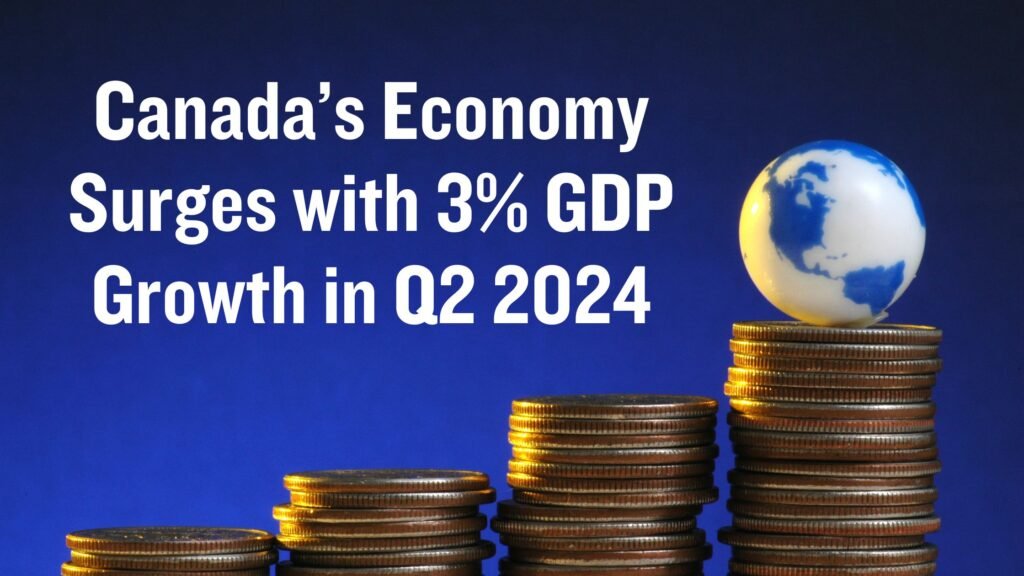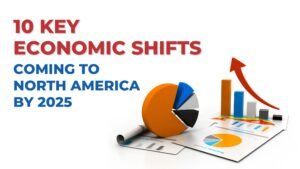Q2 2024 marks a significant surge in Canada’s economy, as the GDP grows up to 3%. Canada faced many economic challenges and disputes over the last few years, and this growth in GDP marks a robust recovery. Facets like increased consumer spending and export, and considerable government investments, have contributed to this remarkable increment in the GDP. In this blog, we will look into the key elements driving Canada’s economic upswing and it holds for the future.
Key Drivers of Canada’s Q2 2024 GDP Growth
1. Consumer Spending Rises
Consumer spending has rebounded, contributing significantly to Canada’s 3% GDP growth. With increasing financial stability, spending has expanded across various sectors in Canada.
- Retail Sales: Consumer spending on retail items has escalated by 4.2% compared to the first quarter of 2024. Previously on a tight budget, Canadians can now spend more on technology, apparel, and household necessities.
- The Covid-19 pandemic had a negative impact on the hotel and tourism industries. The hospitality sector recovered noticeably as the GDP increased significantly. Spending in restaurants and hotels climbed by 6%, demonstrating pre-pandemic travel patterns.
- E-Commerce Growth: E-commerce expenditure and online purchasing climbed by up to 5%, owing to convenience and electronic purchases.
(Source: Statistics Canada)
Unemployment rate stabilized at 6.6% in August 2024, leading to high consumer spending, pushing GDP upward.
2. Increase in Exports
Canada has a powerful export market, which is a compelling force behind the country’s economic progress. Products and services are exported to the United States and China.
- Energy exports soared by 3.5% in the second quarter. This expansion was driven by increased demand for natural gas from Europe and Asia, as well as rising oil prices. (Source: Canadian Association of Petroleum Producers)
- Automotive Industry: Vehicle exports in Canada increased by 5.8%. Electric vehicles (EVs) are in great demand as the Canadian auto industry adjusts to global trends.
- Agricultural Exports: Due to favorable weather and high demand, agricultural exports increased by 4%, particularly cattle and dairy products.
(Source: Statistics Canada)
The Canadian dollar is somewhat weak when compared to the US currency, making Canadian goods more affordable.
3. Government Investments and Infrastructure Projects
Canada’s economic growth in 2024 is driven by government investment on infrastructure and clean energy production. Central and state governments ramped up investments in many sectors, leading to an increase in jobs.
- In Q2, the Canadian government invested around CAD 5 billion in building roads and public transportation. These projects result in an increment in job availability.
- 10% of government funding goes towards renewable energy (wind, solar, etc) projects. This achieves two goals at once, combat climate change and economic growth.
- In urban areas like Vancouver and Toronto, the government has initiated major housing projects. This stimulates real estate development and an increment in jobs.
(Source: Government of Canada’s infrastructure investment reports)
Regional Economic Performance in Q2 2024
Canada‘s overall economy surges with 3% GDP growth, whilst some regions in Canada experienced different levels of economic growth.
Ontario and Quebec: Economic Powerhouses
Ontario is Canada’s most populated province. The GDP grew by 3.2% in the second quarter of 2024. Cities such as Toronto and Ottawa foster the formation of tech start-ups, resulting in the expansion of the technology industry.
Quebec is well-known for its high-tech manufacturing businesses, which have seen a surge in demand for aircraft components and medicines. This industry accounts for a 3.4% growth in the country’s GDP.
Alberta: A Mixed Picture
With the world’s demand for Alberta’s natural resources continuing, the province’s economy is predicted to grow by an average of 2.8% in Q2. This growth will mostly come from the production of energy. Although it is still one of the most significant provinces for gas and oil production, the advancement of renewable energy sources is currently receiving greater attention. Alberta’s energy portfolio is becoming more diversified thanks to solar and wind energy, which also has long-term capital growth potential. However, there are still a number of problems that affect its capacity to finish the shift to a less oil-dependent economy.
Inflation and Interest Rates: Key Concerns
Canada still struggles with soaring inflation and interest rates, despite the GDP growth in Q2 2024.
Inflation Moderation
The Bank of Canada’s initial target is to keep the inflation rates under 2%. The inflation rate peaked in 2023 with about 6.9%, which reduced to 4.5% in Q2 2024. This moderation happened in lieu with international supply chains and lower prices of energy.
Bank of Canada’s Interest Rate Policy
In the first quarter of 2024, Bank of Canada, increased the inflation rate to 4.75% to manage inflation. It’s true that higher interest rates have reduced inflation, but it affected sectors like real estate. Mortgage rates have increased, leading to a decline in prospective buyers.
LookingForward: Economic Outlook for 2024
Canada’s economy surges with 3% GDP growth in Q2 2024, but not without its challenges:
- Geopolitical tensions and supply chain disruptions can hinder the export market.
- Country’s reliance on global trade can be challenging at times.
- The real estate market in Canada is at loss, due to high interest rates.
Conclusion: A Strong Year Ahead?
Surge in Canada’s economy by 3% marks a solid ground in Q2 2024. This increment in GDP is favored by massive consumer spending, global exports, and government investment and initiatives. The country now focuses on green energy, infrastructural development and new technologies. Canada’s economy is not without challenges, but the country with its resilience and strategic investments will stand out in the near future.








Leave a Reply